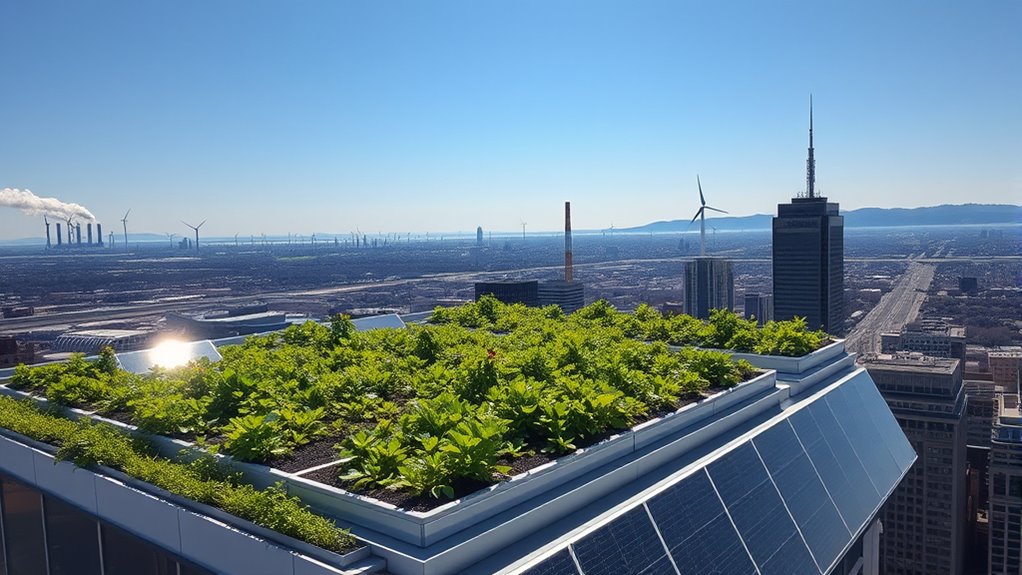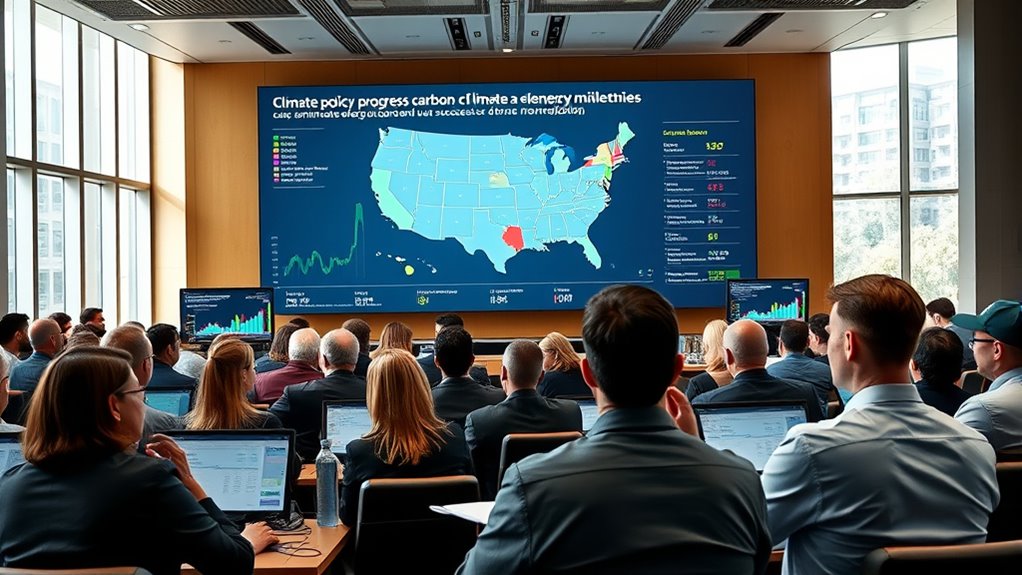By late 2025, the U.S. has made some progress in expanding renewable energy, investing heavily in solar and wind projects. However, legislative gridlock and political divisions still slow down large-scale climate policies and infrastructure efforts. Regional efforts vary, with states pushing ahead despite federal hurdles. Overall, progress is uneven, and many challenges remain before the country can meet its climate targets. To understand what’s really happening behind the scenes, keep exploring the key factors shaping this complex landscape.
Key Takeaways
- U.S. renewable investments have reached record levels, but legislative gridlock has slowed large-scale policy implementation.
- State-level initiatives drive progress, yet federal legislative hurdles hinder nationwide uniform climate action.
- Political divisions and legislative delays continue to obstruct comprehensive climate policy advancement.
- Despite increased clean energy investments, delays threaten to prevent the U.S. from meeting 2030 climate targets.
- Future progress depends on overcoming political stallocks and achieving bipartisan support for climate legislation.

How is the United States progressing on its climate commitments? As 2025 draws to a close, you might wonder whether the country is making meaningful strides toward its ambitious goals. The truth is, progress is a mixed bag. On one hand, there’s been a clear push to ramp up renewable investments, signaling a serious intent to shift away from fossil fuels. On the other hand, legislative hurdles continue to slow down the momentum, complicating efforts to implement thorough policies. You’ve seen headlines about record investments in solar and wind projects, and these signals show that private and public sectors are increasingly aligned on clean energy. Yet, these investments often face delays or uncertainties due to changing political winds and the complex nature of passing legislation at the federal level.
Progress on U.S. climate goals is mixed; renewable investments surge but legislative hurdles slow large-scale progress.
You feel the push from the Biden administration and many states that are actively expanding renewable energy projects. These efforts are essential because they directly contribute to reducing greenhouse gas emissions, aligning with international commitments. But despite this enthusiasm, legislative hurdles stand in the way of large-scale reforms. Congress remains divided on climate policy, with some lawmakers questioning the costs and practicality of aggressive renewable expansion. This division means that many proposed bills, including those intended to provide tax incentives or streamline permitting processes, often stall in committee or face Republican opposition. As a result, what could be swift progress often turns into drawn-out negotiations, limiting the pace at which renewable infrastructure can grow.
You also notice that some states are forging ahead with their own policies, implementing ambitious renewable targets and clean energy standards. These state-level initiatives tend to bypass some federal legislative hurdles, showcasing a patchwork approach to climate action. Still, without thorough federal legislation, the country risks uneven progress, with some regions advancing faster than others. Meanwhile, you see the impact of these legislative hurdles in the slow pace of policy implementation, which hampers large-scale deployment of innovative renewable technologies. The delays mean that the U.S. is not yet on track to meet its 2030 climate targets, despite the investments and political will in certain areas.
In essence, your impression is that while the U.S. has made notable progress in boosting renewable investments, legislative hurdles continue to be a significant obstacle. These challenges create uncertainty and slow down the overall transition to a sustainable energy future. Moving forward, the key will be whether policymakers can find common ground to cut through the legislative gridlock. Only then will the country truly accelerate its climate commitments and realize the full potential of its renewable energy ambitions.
Frequently Asked Questions
How Will Upcoming Elections Influence Climate Policy?
Your voting influence can substantially shape climate policy during upcoming elections. If you vote for candidates prioritizing climate action, you help promote policy stability and progress. Conversely, voting for those who oppose or weaken climate initiatives could lead to setbacks. Your choices directly impact the direction of climate legislation, so staying informed and voting thoughtfully ensures your voice helps foster consistent, effective policies that address climate challenges.
What Are the Economic Impacts of Climate Policy Shifts?
When climate policies shift, you might notice economic impacts like higher energy costs due to carbon taxes, but also new opportunities from renewable subsidies. These changes can boost green industries, creating jobs and encouraging innovation. Conversely, they may challenge traditional sectors, leading to economic adjustments. Staying adaptable helps you navigate these shifts, as policies designed to reduce emissions can also stimulate sustainable growth and long-term economic resilience.
How Do International Agreements Affect U.S. Climate Goals?
International agreements shape your climate goals by encouraging international cooperation and holding the U.S. accountable to treaty commitments. When the U.S. participates actively, it boosts global efforts to reduce emissions, which in turn supports your national climate objectives. However, if the country withdraws or falls short of commitments, it hampers progress and weakens international trust. Your success depends on fulfilling treaty commitments and collaborating effectively with other nations.
What Role Do Technological Innovations Play in Policy Progress?
Technological innovations drive policy progress by making renewable energy more affordable and efficient. You can leverage innovation incentives to develop breakthrough solutions, reducing reliance on fossil fuels and cutting emissions. As you adopt new technologies, you’ll accelerate the shift to cleaner energy sources, helping meet climate goals faster. Innovation fuels progress, empowering you to implement effective policies that harness renewable energy and foster a sustainable future.
How Are Marginalized Communities Impacted by Climate Policy Changes?
Oh, isn’t it charming how climate policies often forget marginalized communities? When policies ignore environmental justice, these groups face the worst impacts—more pollution, fewer resources, and increased vulnerability. Yet, in the grand scheme, their resilience shines through, challenging policies to do better. Your role? Advocate for equitable change, ensuring that every community’s voice is heard, fostering real community resilience and a fairer, healthier future for all.
Conclusion
By late 2025, U.S. climate efforts have seen both wins and setbacks. One striking stat: renewable energy capacity has grown by over 50% since 2022, showing real progress. But challenges remain, like delays in some policy implementations. Stay informed and engaged, because your actions can influence future climate success. Together, we can push for stronger policies and a sustainable future. Every effort counts—your voice matters in shaping the next chapter of climate action.









